Are Seat and Aisle Interferences Affecting the Overall Airplane Boarding Time? An Agent-Based Approach
Abstract
1. Introduction
2. Brief Summary of Boarding Methods and Interferences
2.1. Boarding Methods
2.2. Types of Interferences
3. Agent-Based Modeling in NetLogo
3.1. Methodology and Model’s Parameters
3.2. Modeling the Boarding Process
4. Data Analysis and Discussions
4.1. Data Analysis in Terms of Seat Interferences
4.2. Data Analysis in Terms of Aisle Interferences
4.3. Data Analysis in Terms of Both Seat and Aisle Interferences
4.4. Data Analysis in Terms of Boarding Rules
4.5. Cumulative Data Analysis
5. Conclusions
Author Contributions
Funding
Conflicts of Interest
Appendix A. Summary of Some Boarding Rules for Different Boarding Methods
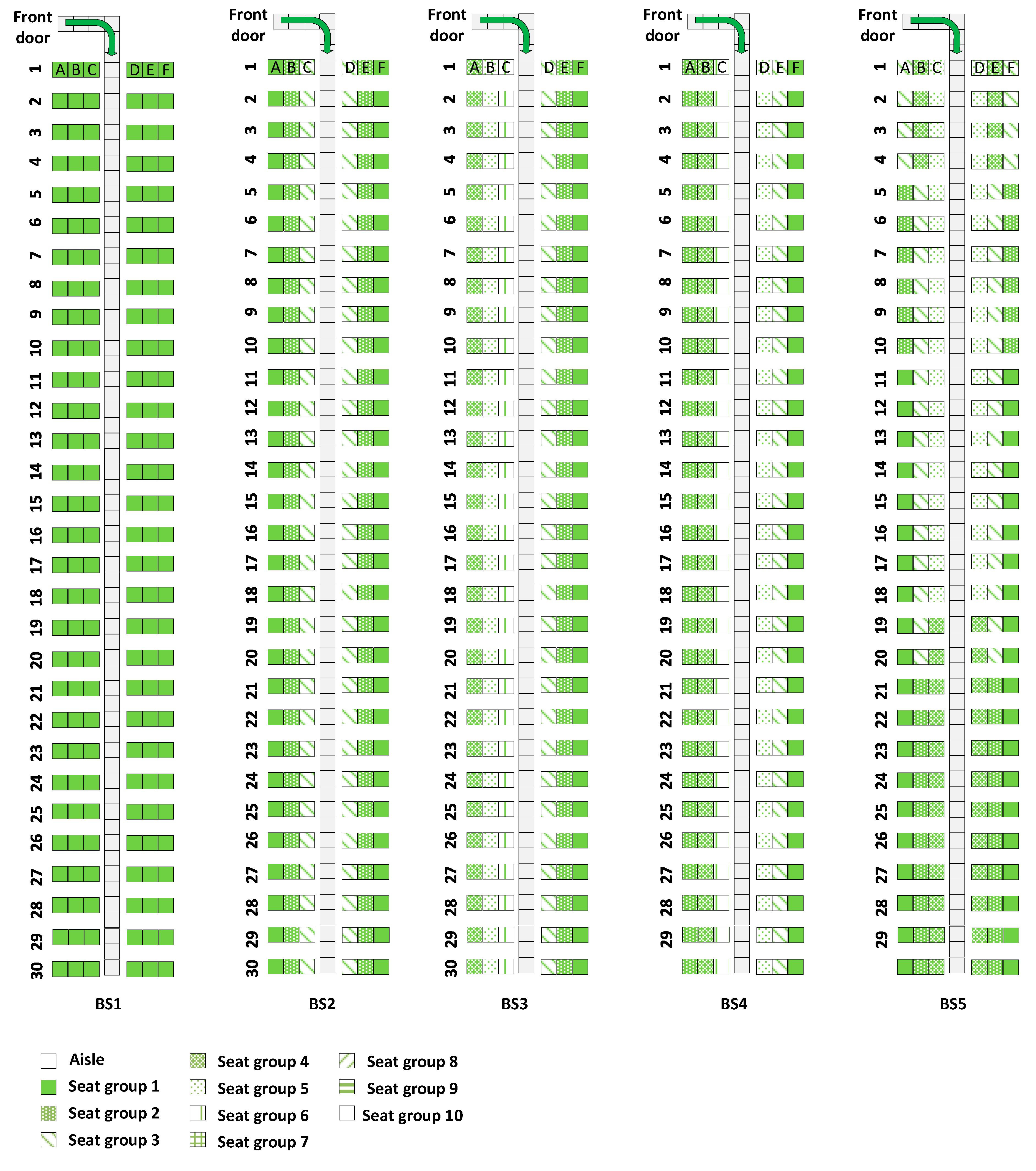
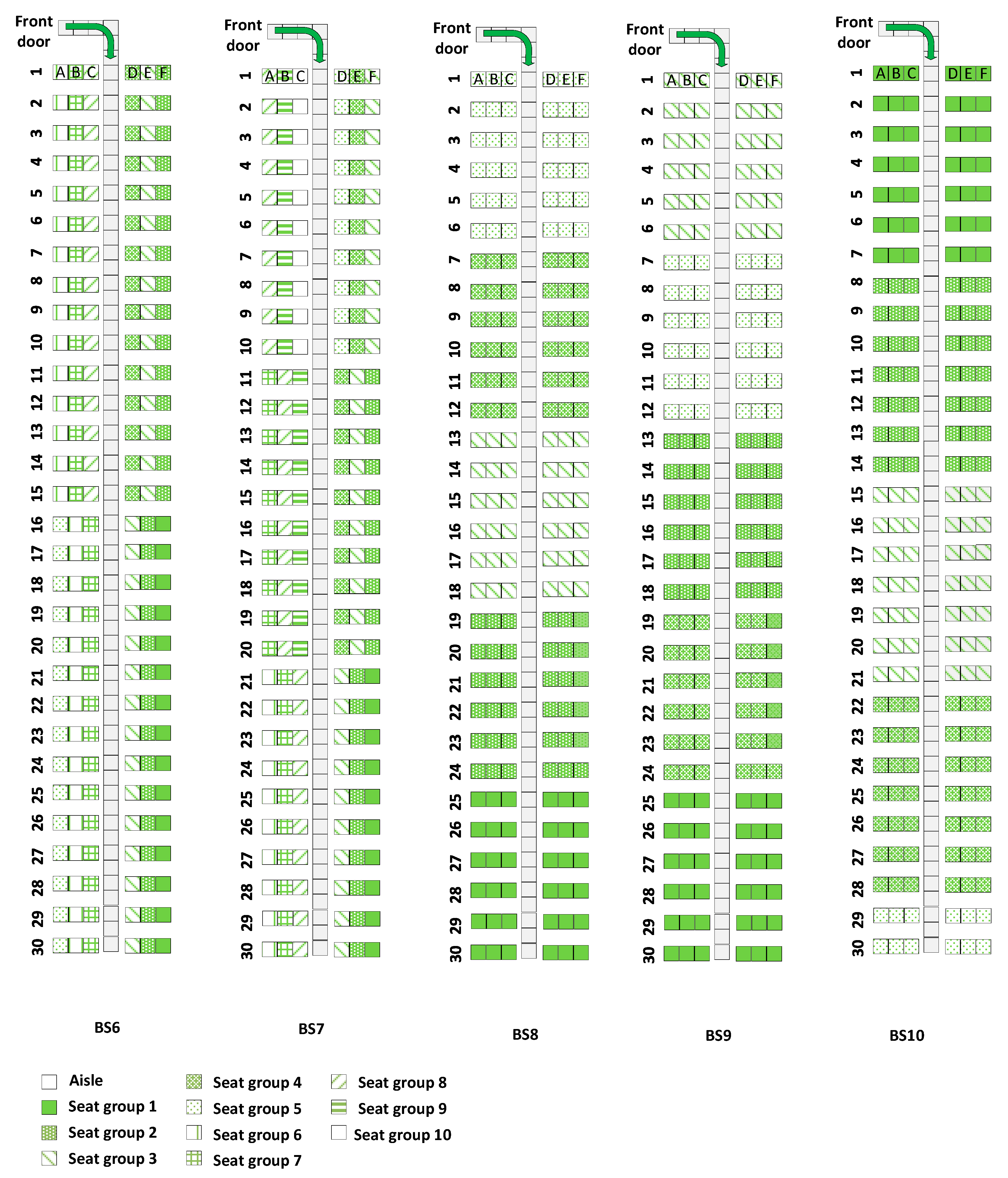
References
- Ren, X.; Xu, X. Experimental analyses of airplane boarding based on interference classification. J. Air Transp. Manag. 2018, 71, 55–63. [Google Scholar] [CrossRef]
- Schmidt, M. A review of aircraft turnaround operations and simulations. Prog. Aerosp. Sci. 2017, 92, 25–38. [Google Scholar] [CrossRef]
- Schultz, M. The Seat Interference Potential as an Indicator for the Aircraft Boarding Progress; No. 2017-01-2113; SAE Technical Paper; SAE: Warrendale, PA, USA, 2017. [Google Scholar]
- Kierzkowski, A.; Kisiel, T. The Human Factor in the Passenger Boarding Process at the Airport. Procedia Eng. 2017, 187, 348–355. [Google Scholar] [CrossRef]
- Eurocontrol. All-Causes Delay and Cancellations to Air Transport in Europe—July 2017. Available online: https://www.eurocontrol.int/sites/default/files/publication/files/flad-july-2017.pdf (accessed on 18 October 2018).
- Nyquist, D.C.; McFadden, K.L. A study of the airline boarding problem. J. Air Transp. Manag. 2008, 14, 197–204. [Google Scholar] [CrossRef]
- Steiner, A.; Philipp, M. Speeding up the airplane boarding process by using pre-boarding areas. In Proceedings of the 9th Swiss Transport Research Conference, Ascona, Switzerland, 9–11 September 2009. [Google Scholar]
- Steffen, J.H. A statistical mechanics model for free-for-all airplane passenger boarding. Am. J. Phys. 2008, 76, 1114–1119. [Google Scholar] [CrossRef]
- Milne, R.J.; Kelly, A.R. A new method for boarding passengers onto an airplane. J. Air Transp. Manag. 2014, 34, 93–100. [Google Scholar] [CrossRef]
- Milne, R.; Salari, M.; Kattan, L. Robust Optimization of Airplane Passenger Seating Assignments. Aerospace 2018, 5, 80. [Google Scholar] [CrossRef]
- Steffen, J.H. Optimal boarding method for airline passengers. J. Air Transp. Manag. 2008, 14, 146–150. [Google Scholar] [CrossRef]
- Qiang, S.-J.; Jia, B.; Xie, D.-F.; Gao, Z.-Y. Reducing airplane boarding time by accounting for passengers’ individual properties: A simulation based on cellular automaton. J. Air Transp. Manag. 2014, 40, 42–47. [Google Scholar] [CrossRef]
- Tang, T.-Q.; Yang, S.-P.; Ou, H.; Chen, L.; Huang, H.-J. An aircraft boarding model with the group behavior and the quantity of luggage. Transp. Res. Part C Emerg. Technol. 2018, 93, 115–127. [Google Scholar] [CrossRef]
- Ferrari, P.; Nagel, K. Robustness of Efficient Passenger Boarding Strategies for Airplanes. Transp. Res. Rec. J. Transp. Res. Board 2005, 1915, 44–54. [Google Scholar] [CrossRef]
- Tang, T.-Q.; Wu, Y.-H.; Huang, H.-J.; Caccetta, L. An aircraft boarding model accounting for passengers’ individual properties. Transp. Res. Part C Emerg. Technol. 2012, 22, 1–16. [Google Scholar] [CrossRef]
- Steffen, J.H.; Hotchkiss, J. Experimental test of airplane boarding methods. J. Air Transp. Manag. 2012, 18, 64–67. [Google Scholar] [CrossRef]
- Van Landeghem, H.; Beuselinck, A. Reducing passenger boarding time in airplanes: A simulation based approach. Eur. J. Oper. Res. 2002, 142, 294–308. [Google Scholar] [CrossRef]
- Van den Briel, M.H.L.; Villalobos, J.R.; Hogg, G.L.; Lindemann, T.; Mulé, A.V. America West Airlines Develops Efficient Boarding Strategies. Interfaces 2005, 35, 191–201. [Google Scholar] [CrossRef]
- Notomista, G.; Selvaggio, M.; Sbrizzi, F.; Di Maio, G.; Grazioso, S.; Botsch, M. A fast airplane boarding strategy using online seat assignment based on passenger classification. J. Air Transp. Manag. 2016, 53, 140–149. [Google Scholar] [CrossRef]
- Zeineddine, H. A dynamically optimized aircraft boarding strategy. J. Air Transp. Manag. 2017, 58, 144–151. [Google Scholar] [CrossRef]
- Bachmat, E.; Berend, D.; Sapir, L.; Skiena, S.; Stolyarov, N. Analysis of Airplane Boarding Times. Oper. Res. 2009, 57, 499–513. [Google Scholar] [CrossRef]
- Schultz, M. Dynamic change of aircraft seat condition for fast boarding. Transp. Res. Part C Emerg. Technol. 2017, 85, 131–147. [Google Scholar] [CrossRef]
- Bazargan, M. A linear programming approach for aircraft boarding strategy. Eur. J. Oper. Res. 2007, 183, 394–411. [Google Scholar] [CrossRef]
- Soolaki, M.; Mahdavi, I.; Mahdavi-Amiri, N.; Hassanzadeh, R.; Aghajani, A. A new linear programming approach and genetic algorithm for solving airline boarding problem. Appl. Math. Model. 2012, 36, 4060–4072. [Google Scholar] [CrossRef]
- Kuo, C.-C. An Improved Zero-One Linear Programming Model for the Plane Boarding Problem. In Applications of Management Science; Applications of Management Science; Emerald Group Publishing Limited: Bingley, UK, 2015; Volume 17, pp. 53–69. [Google Scholar]
- Iyigunlu, S.; Fookes, C.; Yarlagadda, P. Agent-based Modelling of Aircraft Boarding Methods. In Proceedings of the 4th International Conference on Simulation and Modeling Methodologies, Technologies and Applications, Vienna, Austria, 28–30 August 2014; SCITEPRESS—Science and Technology Publications: Vienna, Austria, 2014; pp. 148–154. [Google Scholar]
- Milne, R.J.; Salari, M. Optimization of assigning passengers to seats on airplanes based on their carry-on luggage. J. Air Transp. Manag. 2016, 54, 104–110. [Google Scholar] [CrossRef]
- Delcea, C.; Cotfas, L.-A.; Paun, R. Agent-Based Evaluation of the Airplane Boarding Strategies’ Efficiency and Sustainability. Sustainability 2018, 10, 1879. [Google Scholar] [CrossRef]
- Delcea, C.; Cotfas, L.-A.; Chiriță, N.; Nica, I. A Two-Door Airplane Boarding Approach When Using Apron Buses. Sustainability 2018, 10, 3619. [Google Scholar] [CrossRef]
- Delcea, C.; Cotfas, L.-A.; Paun, R. Airplane Boarding Strategies Using Agent-Based Modeling and Grey Analysis. In Computational Collective Intelligence; Nguyen, N.T., Pimenidis, E., Khan, Z., Trawiński, B., Eds.; Springer International Publishing: Cham, Switzerland, 2018; Volume 11055, pp. 329–339. ISBN 978-3-319-98442-1. [Google Scholar]
- Schultz, M. Field Trial Measurements to Validate a Stochastic Aircraft Boarding Model. Aerospace 2018, 5, 27. [Google Scholar] [CrossRef]
- Qiang, S.; Jia, B.; Huang, Q. Evaluation of Airplane Boarding/Deboarding Strategies: A Surrogate Experimental Test. Symmetry 2017, 9, 222. [Google Scholar] [CrossRef]
- Wilensky, U.; Rand, W. An Introduction to Agent-Based Modeling: Modeling Natural, Social, and Engineered Complex Systems with NetLogo; The MIT Press: Cambridge, MA, USA, 2015; ISBN 978-0-262-73189-8. [Google Scholar]
- Delcea, C.; Bradea, I.A. Economic Cybernetics. An Equation-Based Modeling and Agent-Based Modeling Approach; Editura Universitara: București, Romania, 2017; ISBN 978-606-28-0629-3. [Google Scholar]
- Gao, M.; Zhou, L.; Chen, Y. An Alternative Approach for High Speed Railway Carrying Capacity Calculation Based on Multiagent Simulation. Discret. Dyn. Nat. Soc. 2016, 2016, e4278073. [Google Scholar] [CrossRef]
- Highland, F. Modeling Complexity in Multi-modal Adaptive Survey Systems. Procedia Comput. Sci. 2014, 36, 198–203. [Google Scholar] [CrossRef]
- Riaz, F.; Jabbar, S.; Sajid, M.; Ahmad, M.; Naseer, K.; Ali, N. A collision avoidance scheme for autonomous vehicles inspired by human social norms. Comput. Electr. Eng. 2018. [Google Scholar] [CrossRef]
- Vo, T.T.A.; van der Waerden, P.; Wets, G. Micro-simulation of Car Drivers’ Movements at Parking Lots. Procedia Eng. 2016, 142, 100–107. [Google Scholar] [CrossRef]
- Taboada, M.; Cabrera, E.; Iglesias, M.L.; Epelde, F.; Luque, E. An Agent-Based Decision Support System for Hospitals Emergency Departments. Procedia Comput. Sci. 2011, 4, 1870–1879. [Google Scholar] [CrossRef]
- Prachai, S. The Design of Diabetes Simulation System using Multi-Agent. Procedia Soc. Behav. Sci. 2012, 40, 146–151. [Google Scholar] [CrossRef]
- Pardo, M.; Coronado, W.F. Agent-based Modeling and Simulation to Adoption Process of Information Technologies in Health Systems. IEEE Lat. Am. Trans. 2016, 14, 3358–3363. [Google Scholar] [CrossRef]
- Delcea, C.; Bradea, I.A.; Cotfas, L.A.; Scarlat, E. Opinion influence in online social media environments—U grey system theory and agent-based modeling approach. In Proceedings of the 2017 International Conference on Grey Systems and Intelligent Services (GSIS), Stockholm, Sweden, 8–11 August 2017; pp. 349–355. [Google Scholar]
- Castilla-Rho, J.C.; Mariethoz, G.; Rojas, R.; Andersen, M.S.; Kelly, B.F.J. An agent-based platform for simulating complex human–aquifer interactions in managed groundwater systems. Environ. Model. Softw. 2015, 73, 305–323. [Google Scholar] [CrossRef]
- West, T.A.P.; Grogan, K.A.; Swisher, M.E.; Caviglia-Harris, J.L.; Sills, E.; Harris, D.; Roberts, D.; Putz, F.E. A hybrid optimization-agent-based model of REDD+ payments to households on an old deforestation frontier in the Brazilian Amazon. Environ. Model. Softw. 2018, 100, 159–174. [Google Scholar] [CrossRef]
- Wagner, N.; Agrawal, V. An agent-based simulation system for concert venue crowd evacuation modeling in the presence of a fire disaster. Expert Syst. Appl. 2014, 41, 2807–2815. [Google Scholar] [CrossRef]
- Shi, J.; Ren, A.; Chen, C. Agent-based evacuation model of large public buildings under fire conditions. Autom. Constr. 2009, 18, 338–347. [Google Scholar] [CrossRef]
- Tan, L.; Hu, M.; Lin, H. Agent-based simulation of building evacuation: Combining human behavior with predictable spatial accessibility in a fire emergency. Inf. Sci. 2015, 295, 53–66. [Google Scholar] [CrossRef]
- Dossetti, V.; Bouzat, S.; Kuperman, M.N. Behavioral effects in room evacuation models. Phys. A Stat. Mech. Its Appl. 2017, 479, 193–202. [Google Scholar] [CrossRef]
- Malinowski, A.; Czarnul, P.; Czuryƚo, K.; Maciejewski, M.; Skowron, P. Multi-agent large-scale parallel crowd simulation. Procedia Comput. Sci. 2017, 108, 917–926. [Google Scholar] [CrossRef]
- Oğuz, O.; Akaydın, A.; Yılmaz, T.; Güdükbay, U. Emergency crowd simulation for outdoor environments. Comput. Graph. 2010, 34, 136–144. [Google Scholar] [CrossRef]
- Shendarkar, A.; Vasudevan, K.; Lee, S.; Son, Y.-J. Crowd simulation for emergency response using BDI agents based on immersive virtual reality. Simul. Model. Pract. Theory 2008, 16, 1415–1429. [Google Scholar] [CrossRef]
- Vermuyten, H.; Beliën, J.; De Boeck, L.; Reniers, G.; Wauters, T. A review of optimisation models for pedestrian evacuation and design problems. Saf. Sci. 2016, 87, 167–178. [Google Scholar] [CrossRef]
- Abdelghany, A.; Abdelghany, K.; Mahmassani, H.; Alhalabi, W. Modeling framework for optimal evacuation of large-scale crowded pedestrian facilities. Eur. J. Oper. Res. 2014, 237, 1105–1118. [Google Scholar] [CrossRef]
- Chooramun, N.; Lawrence, P.J.; Galea, E.R. An agent based evacuation model utilising hybrid space discretisation. Saf. Sci. 2012, 50, 1685–1694. [Google Scholar] [CrossRef]
- Ha, V.; Lykotrafitis, G. Agent-based modeling of a multi-room multi-floor building emergency evacuation. Phys. A Stat. Mech. Its Appl. 2012, 391, 2740–2751. [Google Scholar] [CrossRef]
- Delcea, C.; Cotfas, L.-A.; Paun, R. Agent-Based Optimization of the Emergency Exits and Desks Placement in Classrooms. In Computational Collective Intelligence; Nguyen, N.T., Pimenidis, E., Khan, Z., Trawiński, B., Eds.; Springer International Publishing: Cham, Switzerland, 2018; Volume 11055, pp. 340–348. ISBN 978-3-319-98442-1. [Google Scholar]

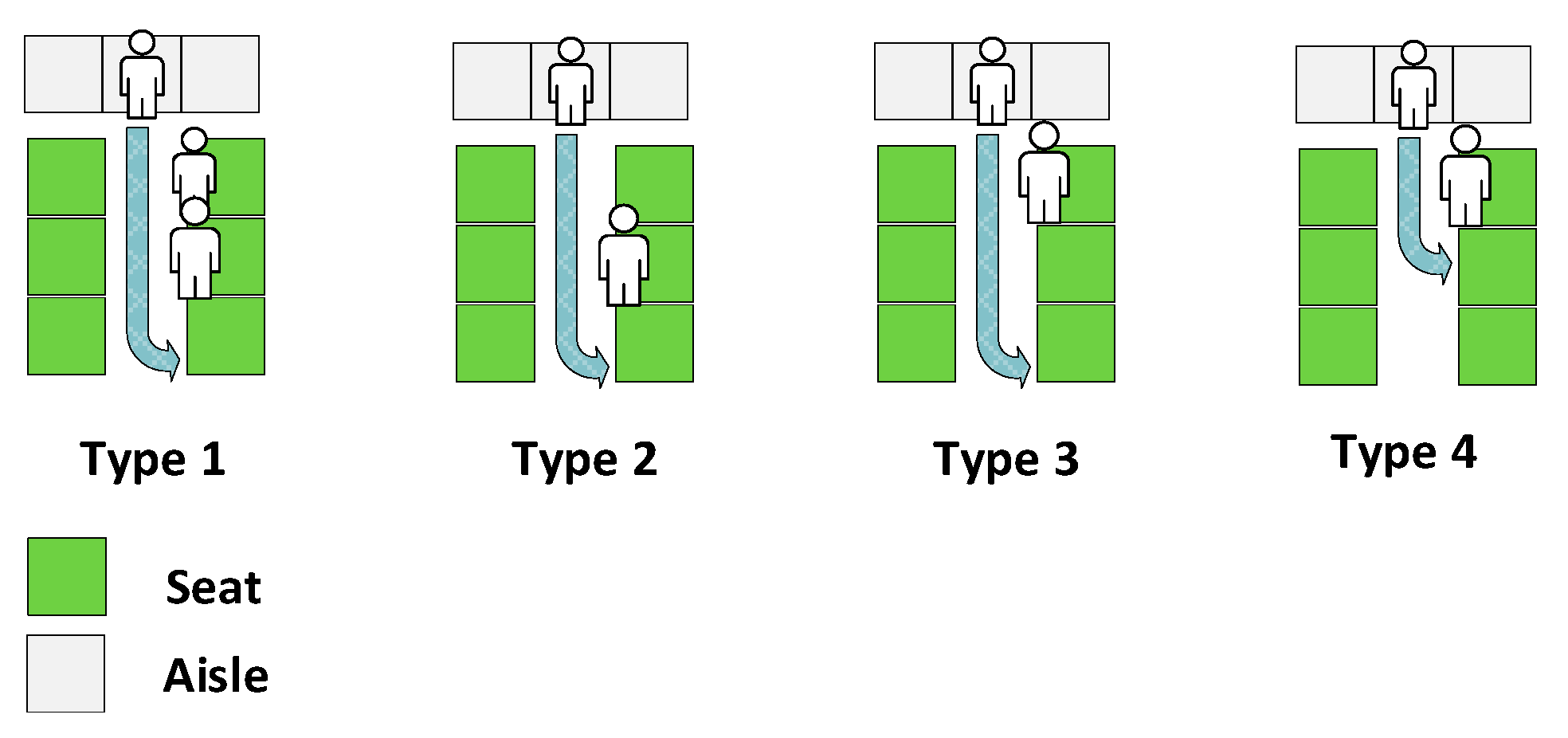
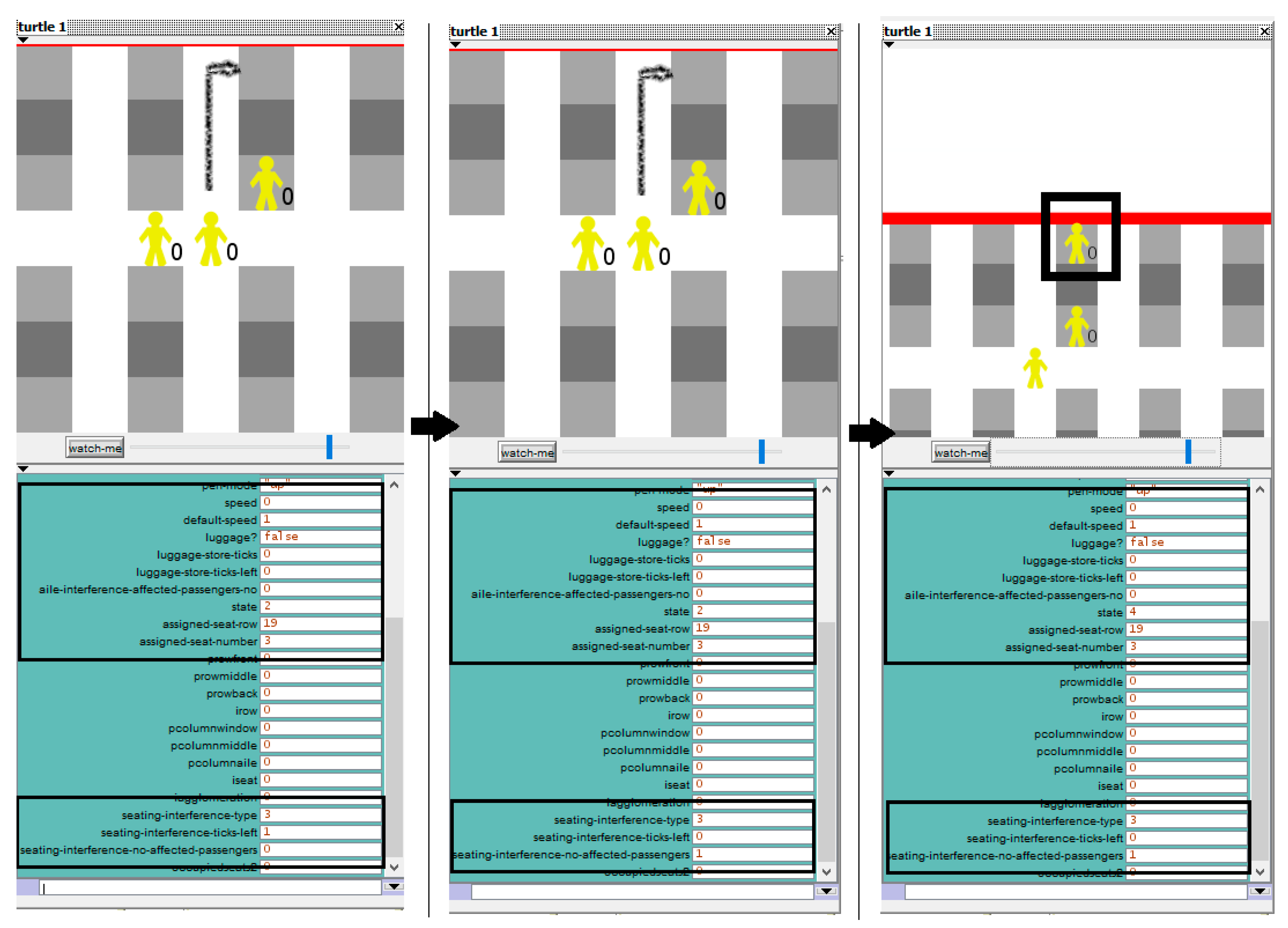
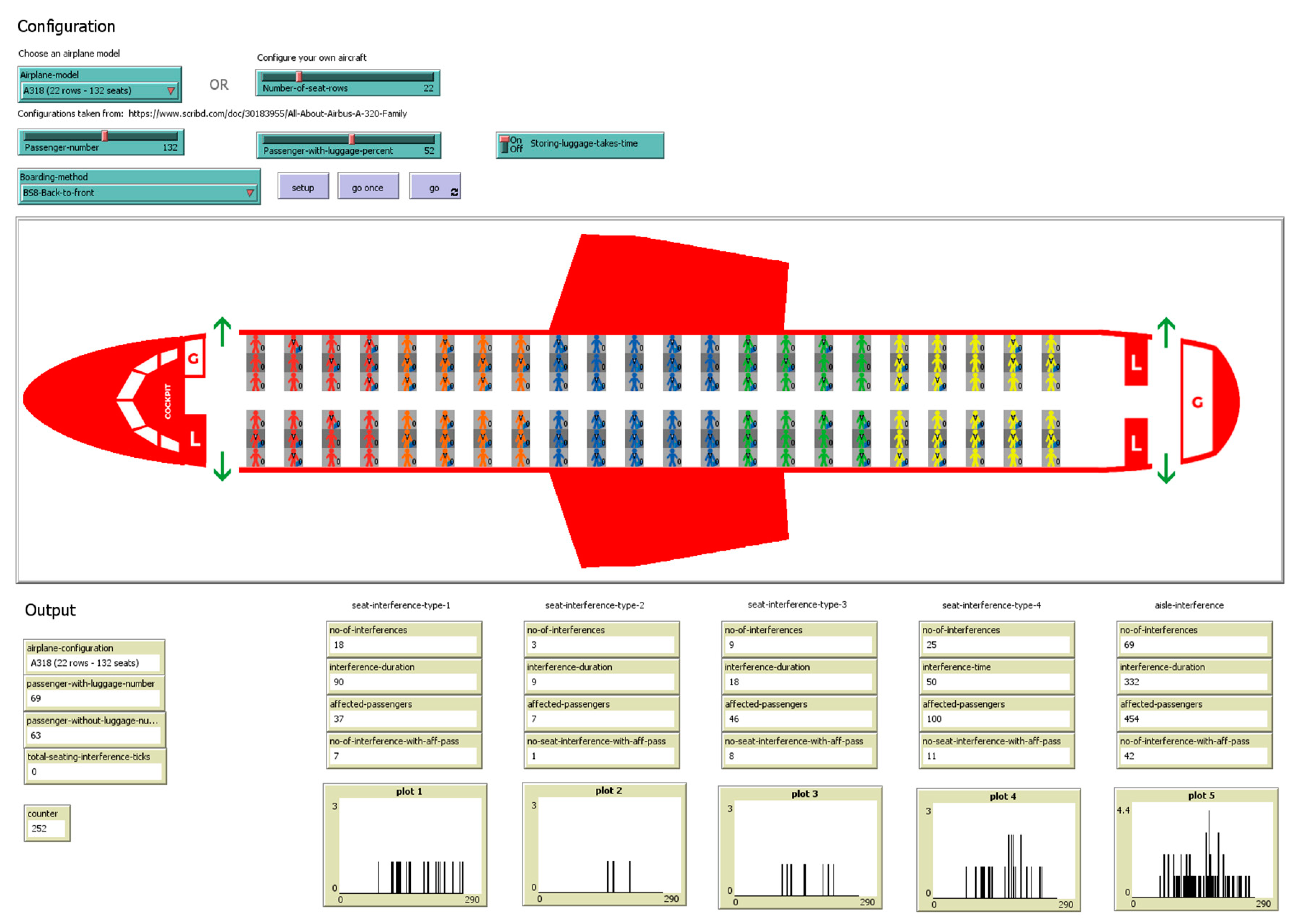

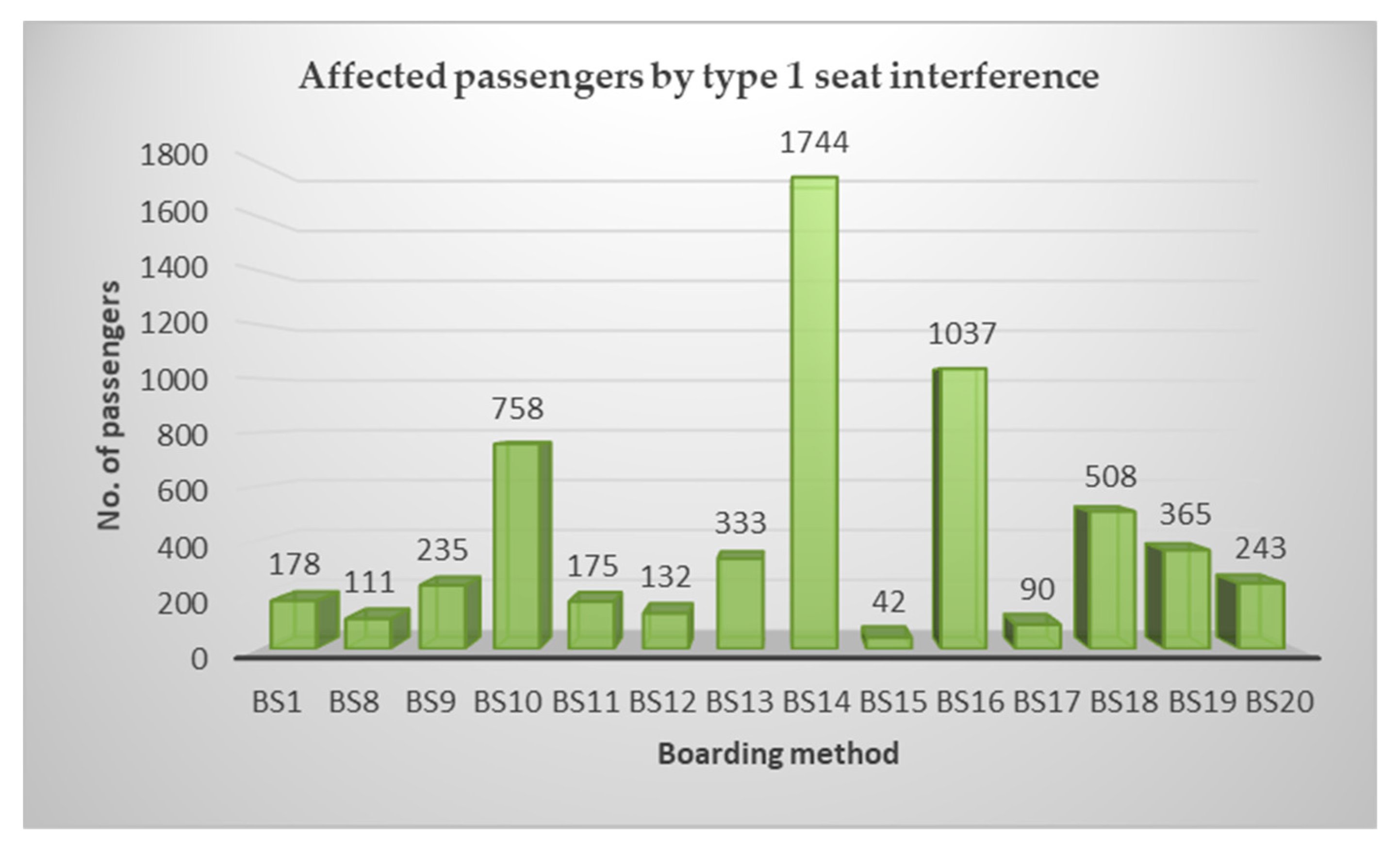

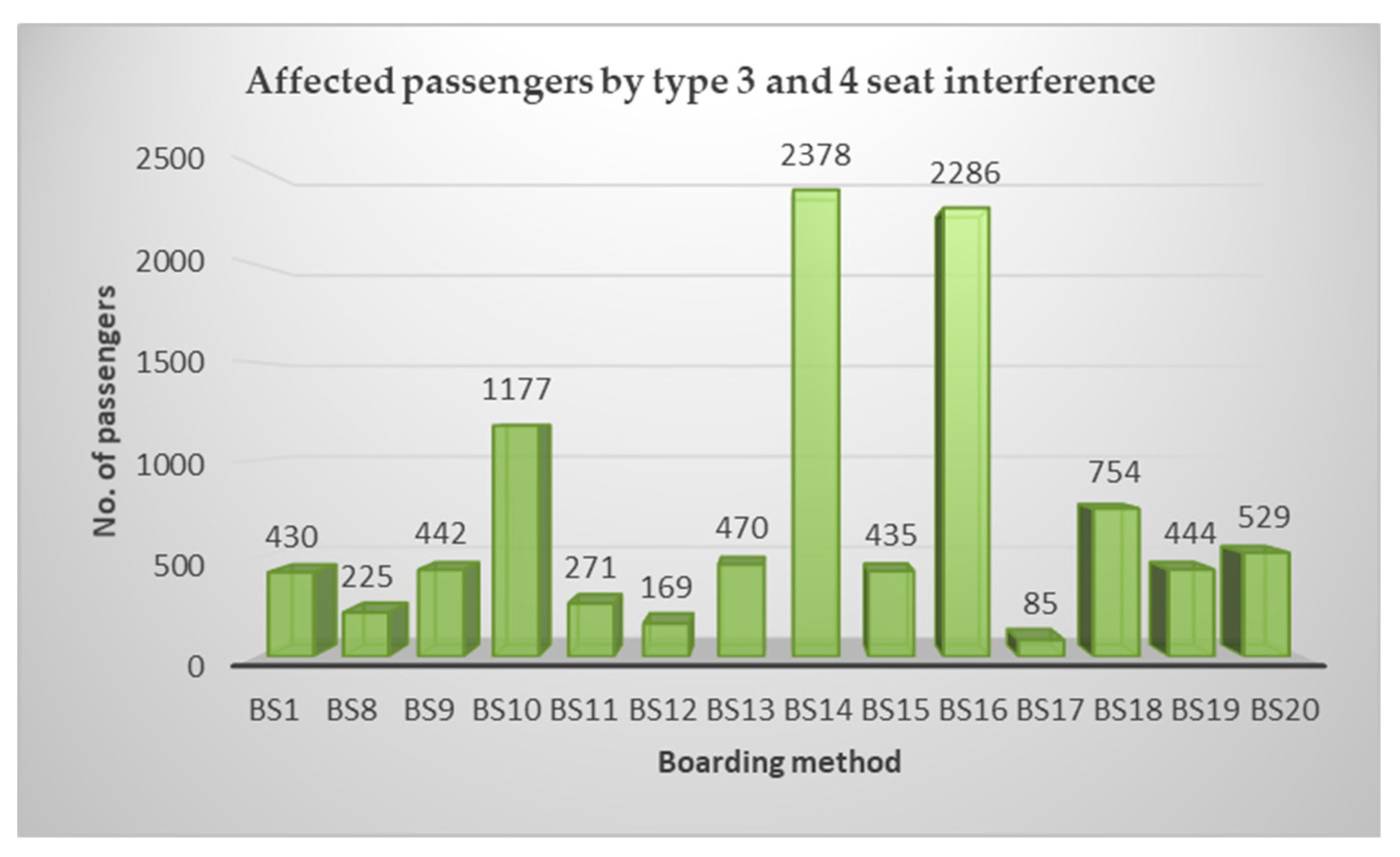
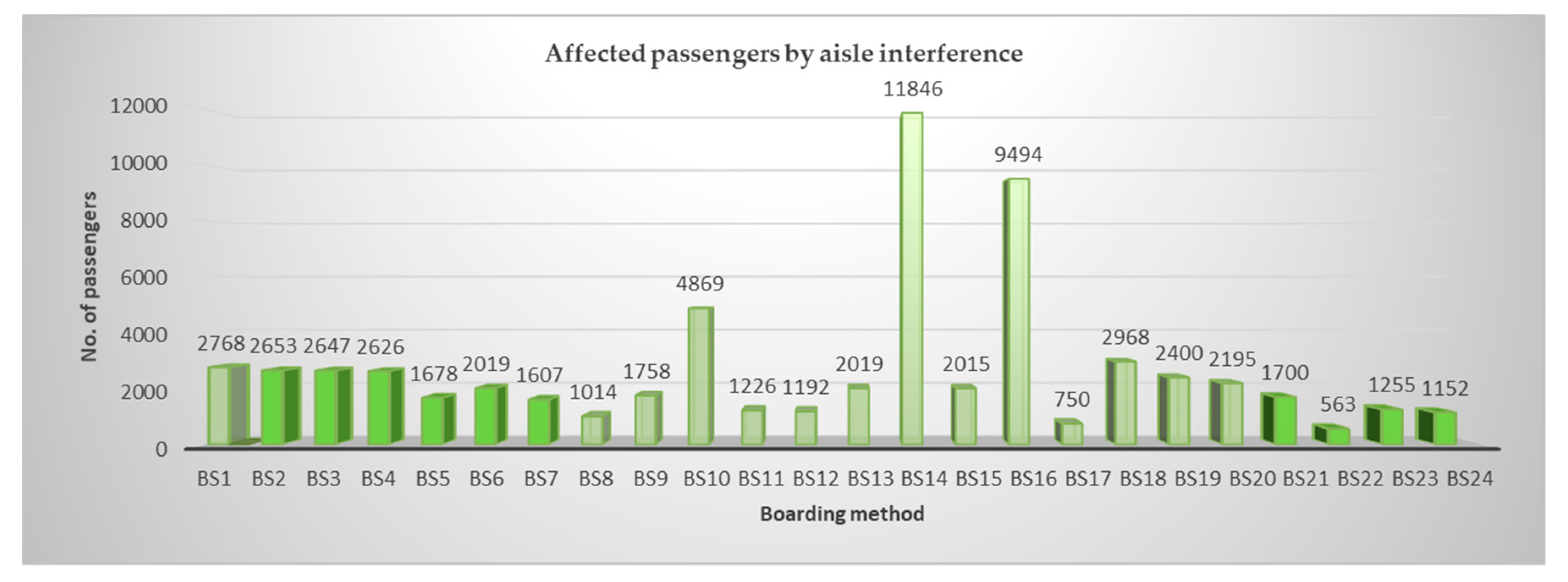
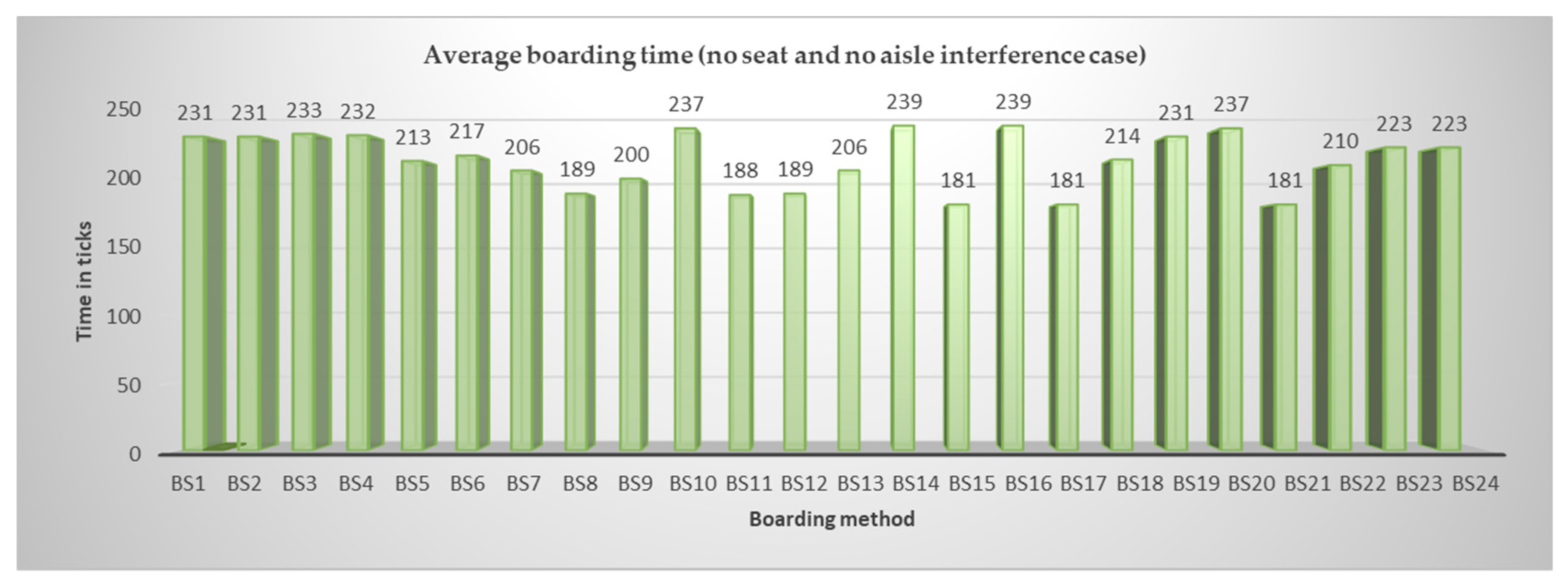
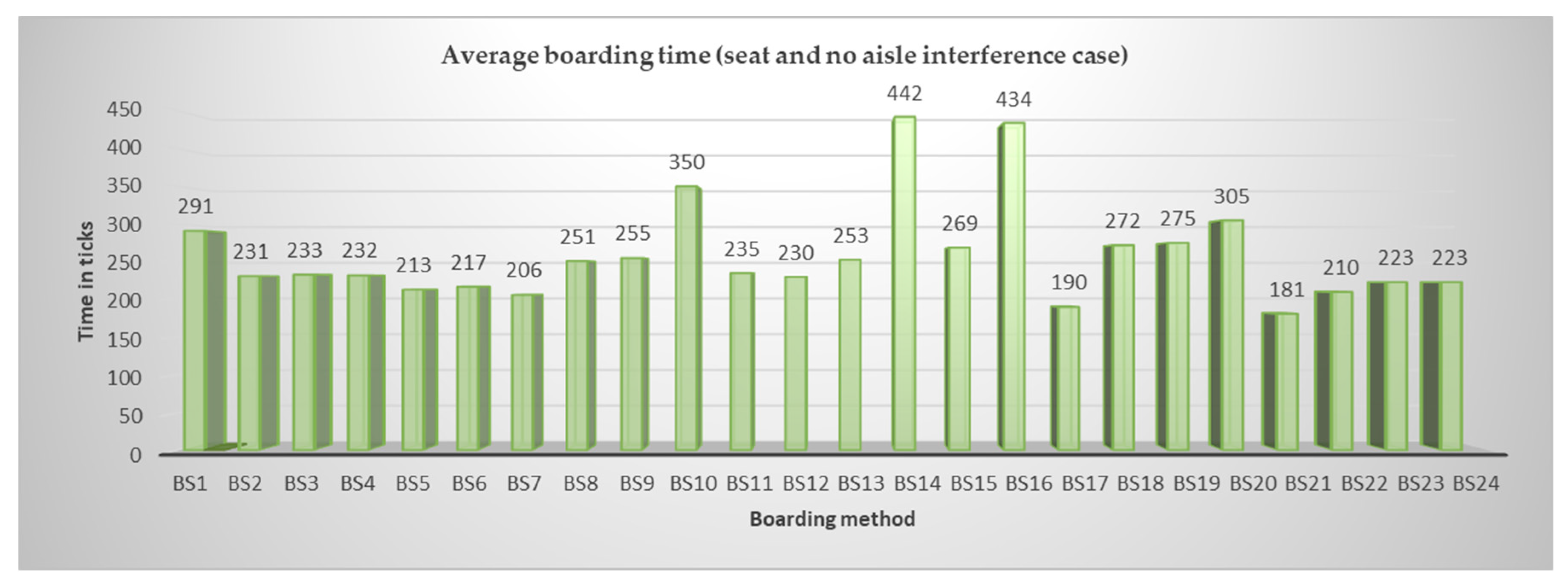
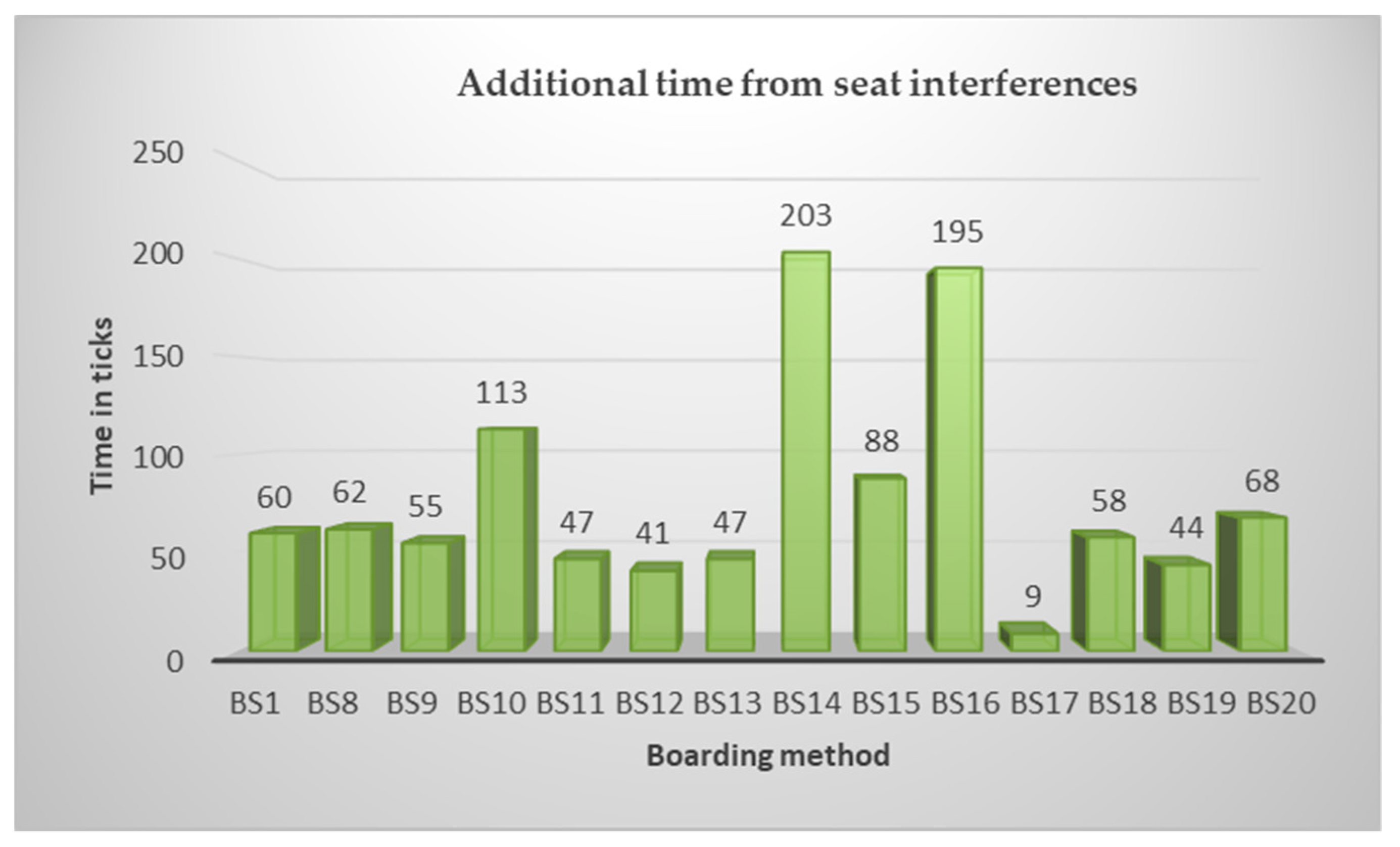
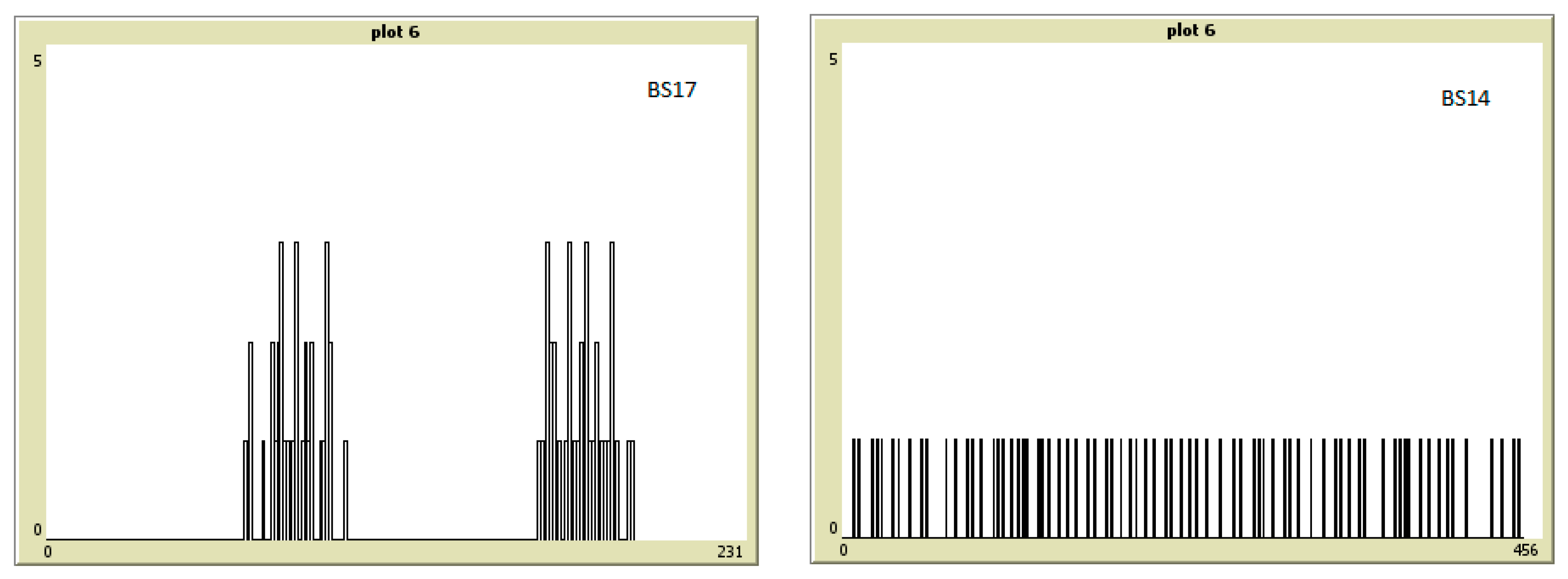
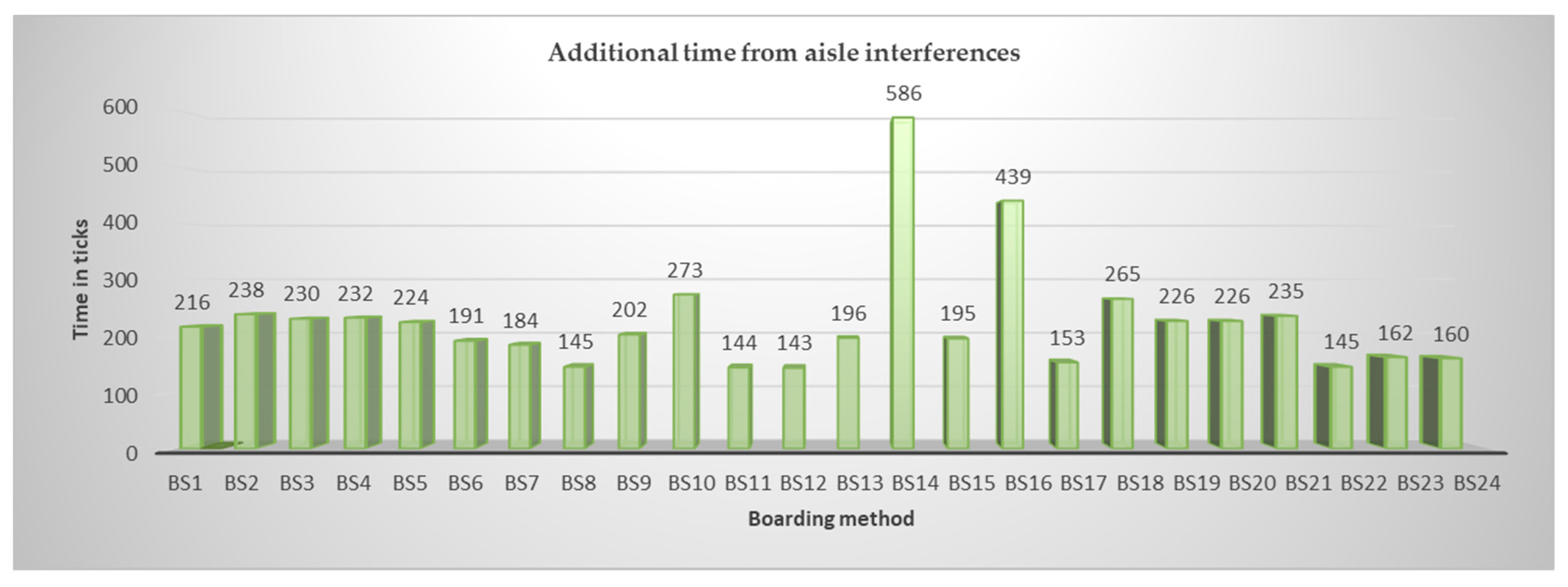
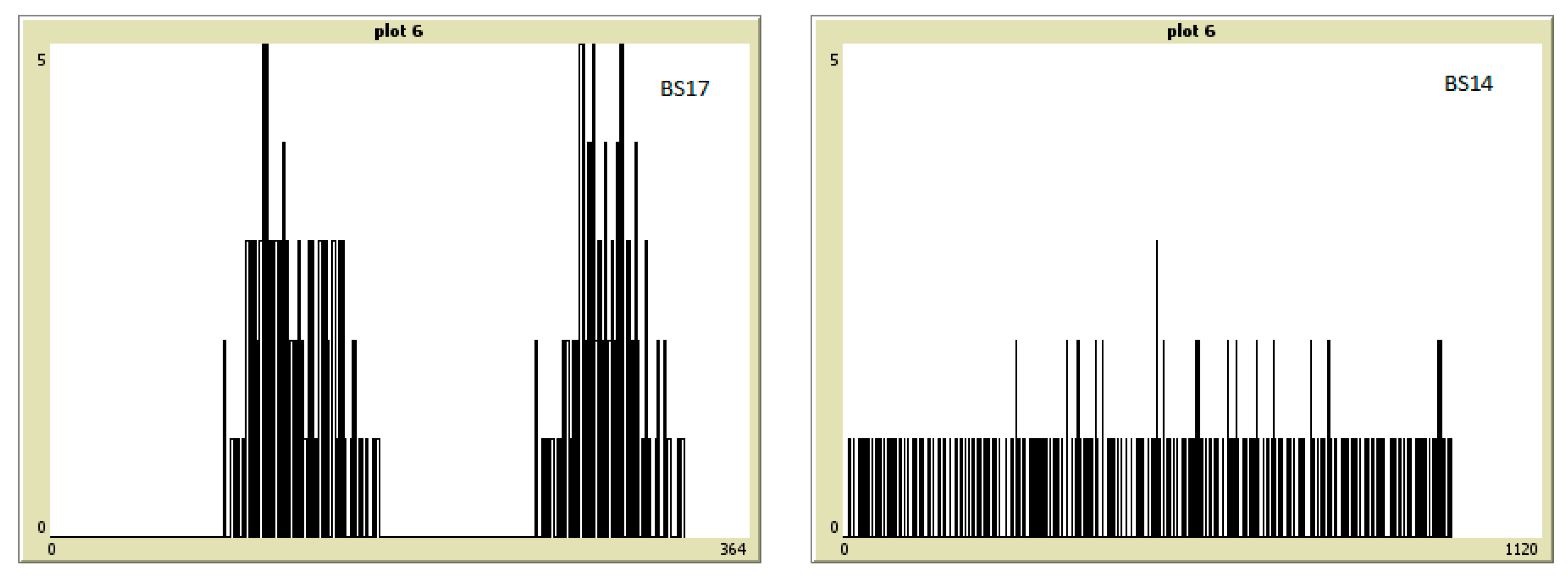
| Classification | Boarding Method | Code | Boarding Strategy |
|---|---|---|---|
| Random | Random with assigned seat | BS1 | Each passenger has an assigned seat on the boarding pass. The passengers are arriving in a random order for boarding. Once inside the aircraft, they are searching for their seat. |
| By group | Outside-in | BS2 | Is a by group strategy, often known in the literature as WilMA (Window-Middle-Aisle). According to this boarding strategy, there are three groups of passengers: the first one made by the passengers having seats near the window (seats marked with A or F), the second group by the passengers having the seats in the middle (letters B and E) and the last group by the passengers with aisle seats (letters C and D). The groups are invited one by one inside the aircraft. |
| Window to aisle half block | BS3 | Similar with outside-in with the only difference that the seating is made first in one side of the aisle, starting from the window to the aisle (seats with letter F, E and D), and then in the other side of the aisle (featuring seats first near the window, letter A, then middle, Letter B, and last near the aisle, letter C). Thus, six boarding groups are possible. | |
| Window to aisle alternate | BS4 | Similar to the outside-in in which one is alternating the groups: the passengers near one window board first, e.g., having letter F on their tickets, then the passengers near the other window, letter A, followed by the middle seats, letters E and B, and last, passengers with aisle seats, letters D and C, which conducts a total of six boarding groups. | |
| Reverse pyramid | BS5 | According to this method, a portion of the window seats located in the back of the airplane are loaded first, then, the rest of the seats near the window and another part of the middle seats are loaded. The loading continues diagonally until all the passengers’ groups are loaded. | |
| Reverse pyramid half-zone (1) | BS6 | A reverse pyramid loaded on half zones, also diagonally, for a total of 8 boarding zones. | |
| Reverse pyramid half-zone (2) | BS7 | Also in half-zones, but considering 10 zones. | |
| Back-to-front | BS8 | The passengers are divided into groups of about 1/5 of the aircraft and are invited to board according to their group, starting from the back of the aircraft. | |
| Back-to-front mix | BS9 | The first group invited to board is located in the rear of the airplane, while the second one is in the middle. A third group boards in the front followed by a group in the middle-back again and a last one in the middle-front. | |
| Front-to-back | BS10 | Starts with a first group in the front of the airplane, then in the front-middle, middle, middle-rear, and rear. | |
| Half-block (back-to-front) | BS11 | Similar to back-to-front but on half-aisles. | |
| Half-block mix (1) | BS12 | It considers boarding first the last group on one side of the aisle, then the second-back group on the other side in diagonal, then, the middle group on the first side, a middle-front group in the second side and last, a front group on the first side. Then, it continues from the back to the front for the remaining groups in the same manner. As a result, 10 boarding zones are needed. | |
| Half-block mix (2) | BS13 | It is similar to applying back-to-front in one side of the aisle and then applying it to the other side of the aisle, for 10 boarding zones, 5 on each side. | |
| By row front-to-back | BS14 | By 6 seat rows, starting from the first row of the airplane and moving up row-by-row until the last row in the back of the airplane is reached. | |
| By row back-to-front | BS15 | By 6 seat rows, starting from the last row of the airplane and moving row-by-row until the first row in the front of the airplane is reached. | |
| By half-row front-to-back | BS16 | Similar to front-to-back, but considering first one side of the aisle and then the other side (by 3 seat rows at a time). | |
| By half-row back-to-front | BS17 | Similar to back-to-front, but considering first one side of the aisle and then the other side (by 3 seat rows at a time). | |
| Rotating zone | BS18 | Considering five zones, the boarding order is: first group in the middle of the aircraft, then the second one in the front, the third one in the back, the fourth in the front-middle and the fifth one in the middle-back. | |
| Modified optimal | BS19 | Consider four zones. One zone is made by all the passengers having odd numbers on their tickets and placed in one side of the aircraft. The second group has the same rules, but is located on the other side of the airplane. The thirst one has the even numbers on the boarding tickets in the first side of the aisle, while the last group has the even numbers on the other side of the aisle. | |
| Non-traditional | BS20 | In general, this is composed of three equal zones (depending on the side of the airplane) and a fourth zone which is considerably smaller (formed by 3 rows). The passengers of the smaller zone located in the middle-back side of the aircraft are boarded first, followed by the ones in the middle zone, then front zone and last, the rear zone. | |
| By seat | Back to front by seating order | BS21 | The first occupied seat is located in the last row of the aircraft near one of the windows, while the second one is near the other window. After that, the middle seats in the last row are occupied in one side and then in the another side of the aisle, followed by the aisle seats. Once the last row is complete, the second-last row is filled-in based on the same rule. The last passenger boarding will have an aisle seat in the first row of the airplane. |
| Descending order | BS22 | It completes seat-by-seat the places near one window starting from the back of the airplane until the front and then, the seats near the other window are filled-in seat-by-seat also from the back to the front. One will proceed in the same way with the middle and then with the aisle seats. | |
| Steffen | BS23 | Similar to a descending order with the only difference being that the window seats are boarded seat-by-seat first on the odd rows, them on the even rows, and after that the middle seats on the odd rows, middle seats on even rows, aisle seats on odd rows, and last, even seats on even rows. | |
| Variation in Steffen | BS24 | Similar to the descending order with the only difference that the window, middle and aisle seats are boarded seat-by-seat only on the odd rows until all the odd rows are filled in. After that, the scheme continues in the same manner for the even rows. |
| Boarding Method | Random | By Group | ||||||||||||
|---|---|---|---|---|---|---|---|---|---|---|---|---|---|---|
| BS1 | BS2 | BS3 | BS4 | BS5 | BS6 | BS7 | BS8 | BS9 | BS10 | BS11 | BS12 | |||
| Avg. boarding time (ticks) | 507 | 469 | 463 | 464 | 437 | 408 | 390 | 396 | 457 | 623 | 379 | 373 | ||
| Seat interference | Type 1 | Avg. no. of interferences | 17 | 0 | 0 | 0 | 0 | 0 | 0 | 23 | 21 | 22 | 21 | 19 |
| Avg. total duration of interferences | 85 | 0 | 0 | 0 | 0 | 0 | 0 | 114 | 103 | 110 | 106 | 95 | ||
| Avg. no. of affected passengers | 178 | 0 | 0 | 0 | 0 | 0 | 0 | 111 | 235 | 758 | 175 | 132 | ||
| Avg. no. of interferences with affected passengers | 13 | 0 | 0 | 0 | 0 | 0 | 0 | 17 | 14 | 17 | 11 | 11 | ||
| Type 2 | Avg. no. of interferences | 15 | 0 | 0 | 0 | 0 | 0 | 0 | 9 | 9 | 9 | 8 | 12 | |
| Avg. total duration of interferences | 44 | 0 | 0 | 0 | 0 | 0 | 0 | 26 | 26 | 26 | 25 | 36 | ||
| Avg. no. of affected passengers | 223 | 0 | 0 | 0 | 0 | 0 | 0 | 58 | 67 | 206 | 53 | 123 | ||
| Avg. no. of interferences with affected passengers | 9 | 0 | 0 | 0 | 0 | 0 | 0 | 6 | 6 | 7 | 6 | 8 | ||
| Type 3 | Avg. no. of interferences | 7 | 0 | 0 | 0 | 0 | 0 | 0 | 11 | 11 | 8 | 10 | 11 | |
| Avg. total duration of interferences | 14 | 0 | 0 | 0 | 0 | 0 | 0 | 23 | 22 | 15 | 21 | 21 | ||
| Avg. no. of affected passengers | 155 | 0 | 0 | 0 | 0 | 0 | 0 | 62 | 116 | 200 | 74 | 25 | ||
| Avg. no. of interferences with affected passengers | 6 | 0 | 0 | 0 | 0 | 0 | 0 | 7 | 8 | 6 | 6 | 6 | ||
| Type 4 | Avg. no. of interferences | 25 | 0 | 0 | 0 | 0 | 0 | 0 | 32 | 32 | 29 | 30 | 26 | |
| Avg. total duration of interferences | 51 | 0 | 0 | 0 | 0 | 0 | 0 | 65 | 64 | 58 | 60 | 54 | ||
| Avg. no. of affected passengers | 275 | 0 | 0 | 0 | 0 | 0 | 0 | 163 | 326 | 977 | 197 | 144 | ||
| Avg. no. of interferences with affected passengers | 17 | 0 | 0 | 0 | 0 | 0 | 0 | 21 | 19 | 20 | 17 | 13 | ||
| Aisle interference | Avg. no. of interferences | 180 | 180 | 180 | 180 | 180 | 180 | 180 | 180 | 180 | 180 | 180 | 180 | |
| Avg. total duration of interferences | 901 | 891 | 910 | 904 | 883 | 886 | 917 | 903 | 901 | 928 | 895 | 884 | ||
| Avg. no. of affected passengers | 2768 | 2653 | 2647 | 2626 | 1678 | 2019 | 1607 | 1014 | 1758 | 4869 | 1226 | 1192 | ||
| Avg. no. of interferences with affected passengers | 112 | 111 | 106 | 103 | 108 | 103 | 108 | 115 | 108 | 122 | 106 | 98 | ||
| Boarding Method | By Group | By Seat | ||||||||||||
|---|---|---|---|---|---|---|---|---|---|---|---|---|---|---|
| BS13 | BS14 | BS15 | BS16 | BS17 | BS18 | BS19 | BS20 | BS21 | BS22 | BS23 | BS24 | |||
| Avg. boarding time (ticks) | 449 | 1028 | 464 | 873 | 343 | 537 | 501 | 531 | 416 | 355 | 385 | 383 | ||
| Seat interference | Type 1 | Avg. no. of interferences | 19 | 21 | 18 | 15 | 21 | 21 | 19 | 18 | 0 | 0 | 0 | 0 |
| Avg. total duration of interferences | 96 | 105 | 91 | 75 | 103 | 105 | 94 | 91 | 0 | 0 | 0 | 0 | ||
| Avg. no. of affected passengers | 333 | 1744 | 42 | 1037 | 90 | 508 | 365 | 243 | 0 | 0 | 0 | 0 | ||
| Avg. no. of interferences with affected passengers | 11 | 19 | 8 | 15 | 1 | 17 | 11 | 14 | 0 | 0 | 0 | 0 | ||
| Type 2 | Avg. no. of interferences | 9 | 10 | 12 | 11 | 9 | 7 | 8 | 11 | 2 | 0 | 0 | 0 | |
| Avg. total duration of interferences | 28 | 30 | 36 | 32 | 28 | 21 | 25 | 34 | 6 | 0 | 0 | 0 | ||
| Avg. no. of affected passengers | 133 | 983 | 117 | 717 | 8 | 75 | 120 | 97 | 25 | 0 | 0 | 0 | ||
| Avg. no. of interferences with affected passengers | 7 | 9 | 9 | 10 | 7 | 7 | 6 | 9 | 1 | 0 | 0 | 0 | ||
| Type 3 | Avg. no. of interferences | 9 | 12 | 12 | 11 | 9 | 12 | 11 | 11 | 0 | 0 | 0 | 0 | |
| Avg. total duration of interferences | 18 | 24 | 24 | 21 | 18 | 24 | 21 | 21 | 0 | 0 | 0 | 0 | ||
| Avg. no. of affected passengers | 49 | 531 | 179 | 698 | 5 | 148 | 56 | 122 | 0 | 0 | 0 | 0 | ||
| Avg. no. of interferences with affected passengers | 5 | 7 | 9 | 8 | 5 | 8 | 7 | 6 | 0 | 0 | 0 | 0 | ||
| Type 4 | Avg. no. of interferences | 30 | 29 | 31 | 28 | 31 | 33 | 31 | 32 | 2 | 0 | 0 | 0 | |
| Avg. total duration of interferences | 55 | 58 | 61 | 56 | 63 | 65 | 62 | 65 | 4 | 0 | 0 | 0 | ||
| Avg. no. of affected passengers | 421 | 1847 | 256 | 1588 | 80 | 606 | 388 | 407 | 1 | 0 | 0 | 0 | ||
| Avg. no. of interferences with affected passengers | 17 | 22 | 14 | 26 | 12 | 21 | 20 | 22 | 1 | 0 | 0 | 0 | ||
| Aisle interference | Avg. no. of interferences | 180 | 180 | 180 | 180 | 180 | 180 | 180 | 180 | 180 | 180 | 180 | 180 | |
| Avg. total duration of interferences | 896 | 905 | 900 | 917 | 906 | 893 | 900 | 889 | 895 | 916 | 893 | 911 | ||
| Avg. no. of affected passengers | 2019 | 11846 | 2015 | 9494 | 750 | 2968 | 2400 | 2195 | 1700 | 563 | 1255 | 1152 | ||
| Avg. no. of interferences with affected passengers | 102 | 137 | 108 | 149 | 86 | 120 | 111 | 113 | 106 | 7 | 23 | 20 | ||
© 2018 by the authors. Licensee MDPI, Basel, Switzerland. This article is an open access article distributed under the terms and conditions of the Creative Commons Attribution (CC BY) license (http://creativecommons.org/licenses/by/4.0/).
Share and Cite
Delcea, C.; Cotfas, L.-A.; Crăciun, L.; Molanescu, A.G. Are Seat and Aisle Interferences Affecting the Overall Airplane Boarding Time? An Agent-Based Approach. Sustainability 2018, 10, 4217. https://doi.org/10.3390/su10114217
Delcea C, Cotfas L-A, Crăciun L, Molanescu AG. Are Seat and Aisle Interferences Affecting the Overall Airplane Boarding Time? An Agent-Based Approach. Sustainability. 2018; 10(11):4217. https://doi.org/10.3390/su10114217
Chicago/Turabian StyleDelcea, Camelia, Liviu-Adrian Cotfas, Liliana Crăciun, and Anca Gabriela Molanescu. 2018. "Are Seat and Aisle Interferences Affecting the Overall Airplane Boarding Time? An Agent-Based Approach" Sustainability 10, no. 11: 4217. https://doi.org/10.3390/su10114217
APA StyleDelcea, C., Cotfas, L.-A., Crăciun, L., & Molanescu, A. G. (2018). Are Seat and Aisle Interferences Affecting the Overall Airplane Boarding Time? An Agent-Based Approach. Sustainability, 10(11), 4217. https://doi.org/10.3390/su10114217







